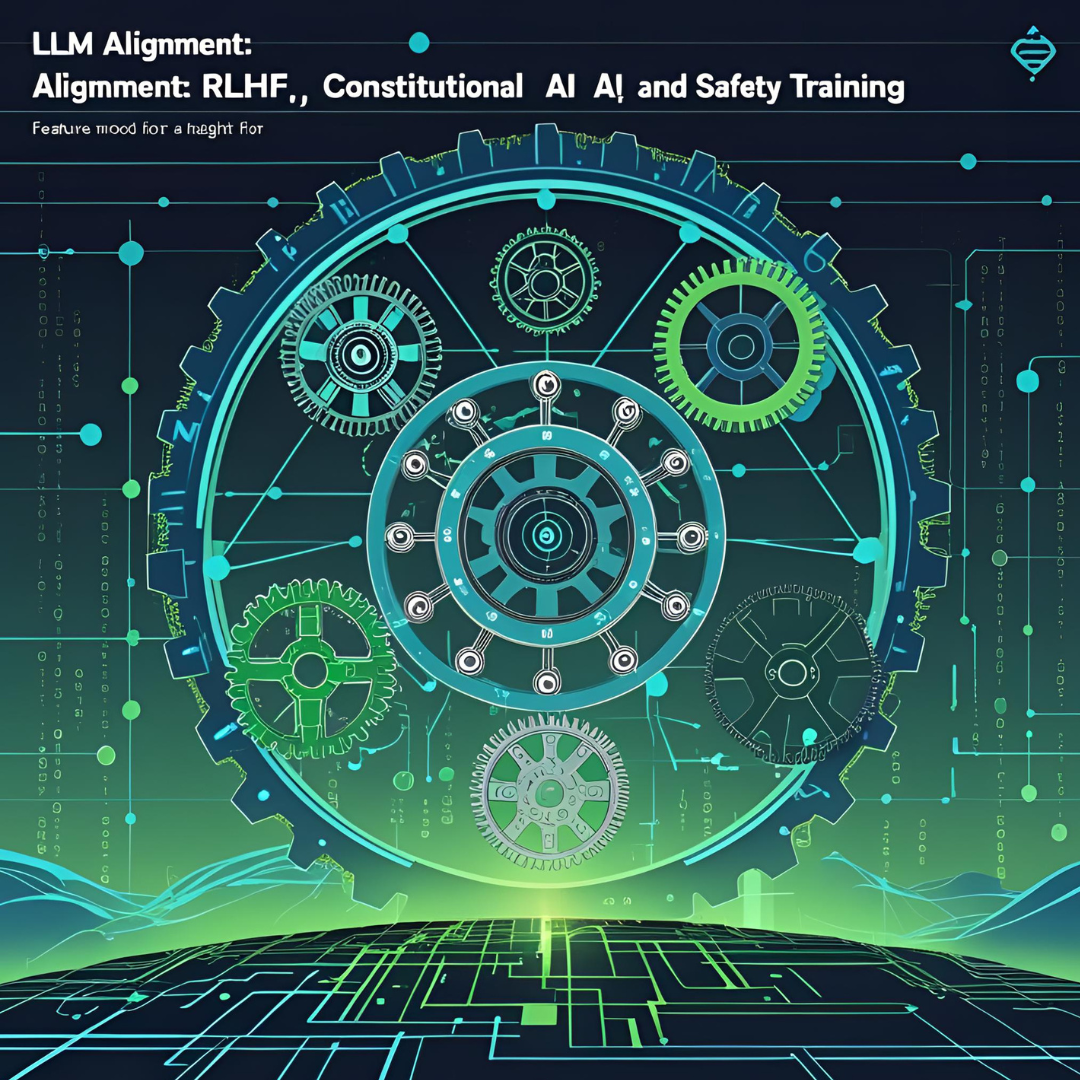As Large Language Models (LLMs) become increasingly powerful and integrated into our daily lives, ensuring they behave safely and align with human values has become one of the most critical challenges in AI development. This post explores three key approaches to LLM alignment: Reinforcement Learning from Human Feedback (RLHF), Constitutional AI, and Safety Training.
Understanding the Alignment Problem
The alignment problem refers to the challenge of ensuring AI systems pursue objectives that are aligned with human values and intentions. For LLMs, this means creating models that are helpful, harmless, and honest while avoiding harmful outputs like misinformation, toxic content, or dangerous instructions.
The stakes are high: misaligned AI systems could cause significant harm through biased decisions, manipulation, or by providing harmful information. As LLMs become more capable, robust alignment techniques become essential for safe deployment.
Reinforcement Learning from Human Feedback (RLHF)
What is RLHF?
RLHF is a training methodology that uses human preferences to fine-tune language models. Instead of relying solely on traditional supervised learning, RLHF incorporates human judgment to shape model behavior.
The RLHF Process
The RLHF pipeline typically involves three key stages:
1. Supervised Fine-Tuning (SFT)
- Start with a pre-trained language model
- Fine-tune on high-quality demonstration data
- Human annotators provide examples of desired responses
2. Reward Model Training
- Collect human preference data by having annotators rank model outputs
- Train a reward model to predict human preferences
- This model learns to score outputs based on human judgment
3. Reinforcement Learning Optimization
- Use the reward model to fine-tune the language model
- Apply reinforcement learning algorithms (typically PPO – Proximal Policy Optimization)
- The model learns to generate outputs that maximize the reward signal
Benefits and Challenges
Benefits:
- Directly incorporates human values and preferences
- Effective at reducing harmful outputs
- Improves helpfulness and instruction-following
Challenges:
- Requires substantial human annotation effort
- Human preferences can be inconsistent or biased
- Potential for reward hacking or specification gaming
- Scalability concerns as models become more complex
Constitutional AI (CAI)
The Constitutional Approach
Constitutional AI, developed by Anthropic, takes inspiration from constitutional law to create a set of principles that guide AI behavior. Instead of relying purely on human feedback, CAI uses a constitution—a set of rules and principles—to evaluate and improve model outputs.
How Constitutional AI Works
1. Constitutional Training
- Define a constitution with specific principles and rules
- Use the model to critique and revise its own outputs based on these principles
- Apply self-supervised learning to improve alignment
2. Self-Critique and Revision
- The model generates initial responses
- It then critiques these responses against constitutional principles
- Finally, it revises the responses to better align with the constitution
3. Principle-Based Evaluation
- Responses are evaluated against explicit principles
- Examples include being helpful, harmless, honest, and respectful
- The model learns to internalize these principles during training
Advantages of Constitutional AI
- Transparency: Clear, explicit principles guide behavior
- Scalability: Reduces dependence on human feedback
- Consistency: Principles provide stable evaluation criteria
- Flexibility: Constitutions can be updated as values evolve
Safety Training Approaches
Multi-Layered Safety
Modern LLM safety training employs multiple complementary approaches:
Content Filtering
- Pre-training data filtering to remove harmful content
- Real-time output filtering to catch problematic responses
- Multi-stage filtering systems with different sensitivity levels
Robustness Training
- Adversarial training to handle edge cases
- Red teaming exercises to identify vulnerabilities
- Stress testing with challenging prompts
Value Learning
- Training models to understand and respect human values
- Cultural sensitivity training for global deployment
- Bias detection and mitigation techniques
Safety Evaluation Frameworks
Automated Testing
- Large-scale safety evaluations using automated systems
- Continuous monitoring of model outputs
- Benchmarking against safety metrics
Human Evaluation
- Expert review of model capabilities and limitations
- Diverse human feedback across different demographics
- Specialized evaluation for high-risk domains
Combining Approaches: The Future of Alignment
Integrated Systems
The most effective alignment strategies combine multiple approaches:
- RLHF + Constitutional AI: Using human feedback to inform constitutional principles
- Safety Training + RLHF: Layering safety constraints with preference learning
- Constitutional AI + Automated Safety: Combining principled approaches with systematic testing
Emerging Techniques
Scalable Oversight
- Training AI systems to assist in evaluating other AI systems
- Reducing human labor requirements for safety evaluation
- Maintaining quality while increasing scale
Interpretability Integration
- Understanding why models make certain decisions
- Identifying potential misalignment before deployment
- Building trust through transparency
Dynamic Alignment
- Adapting alignment techniques as models become more capable
- Continuous learning from deployment feedback
- Evolving safety measures with advancing technology
Challenges and Future Directions
Current Limitations
- Specification Difficulty: Precisely defining human values remains challenging
- Cultural Variations: Values differ across cultures and contexts
- Capability-Alignment Gap: Alignment techniques may not scale with capability improvements
- Evaluation Challenges: Measuring alignment effectiveness is complex
Research Frontiers
Advanced Reward Modeling
- More sophisticated preference learning
- Handling complex, multi-faceted human values
- Resolving conflicting preferences
Mechanistic Interpretability
- Understanding internal model representations
- Identifying alignment-relevant model components
- Developing targeted interventions
Formal Verification
- Mathematical guarantees about model behavior
- Provably safe AI systems
- Verified alignment properties
Practical Implementation
For Developers
When implementing LLM alignment techniques:
- Start with Clear Objectives: Define what alignment means for your specific use case
- Use Multiple Approaches: Combine RLHF, constitutional principles, and safety training
- Continuous Evaluation: Implement ongoing assessment of alignment effectiveness
- Stakeholder Involvement: Include diverse perspectives in defining alignment criteria
- Iterative Improvement: Regularly update alignment techniques based on findings
For Organizations
- Establish clear AI ethics guidelines
- Invest in alignment research and development
- Create diverse teams for alignment evaluation
- Maintain transparency about alignment approaches
- Prepare for evolving regulatory requirements
Conclusion
LLM alignment through RLHF, Constitutional AI, and Safety Training represents our current best efforts to create AI systems that serve humanity safely and beneficially. While each approach has its strengths and limitations, their combination offers the most promising path forward.
The field of AI alignment is rapidly evolving, with new techniques and insights emerging regularly. Success will require continued research, collaboration across the AI community, and careful attention to the diverse needs and values of global society.
As we advance toward more capable AI systems, robust alignment techniques become not just beneficial but essential. The investments we make in alignment today will determine whether tomorrow’s AI systems truly serve human flourishing.
The journey toward aligned AI is complex and ongoing, but through techniques like RLHF, Constitutional AI, and comprehensive safety training, we’re building the foundation for a future where powerful AI systems remain helpful, harmless, and aligned with human values.


Leave a Reply